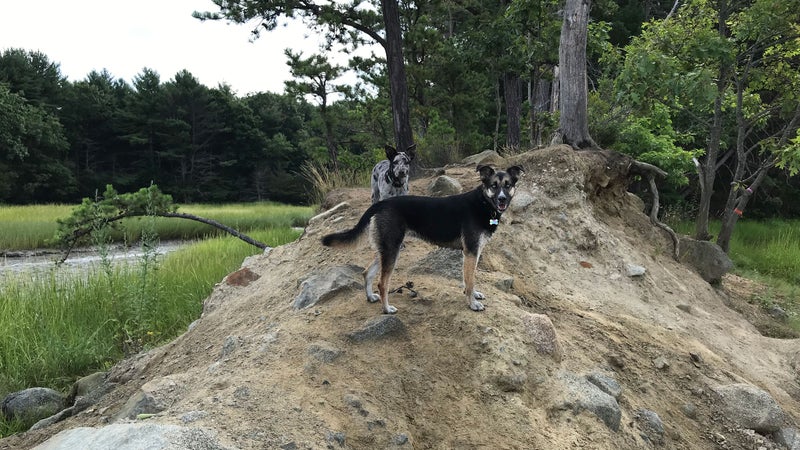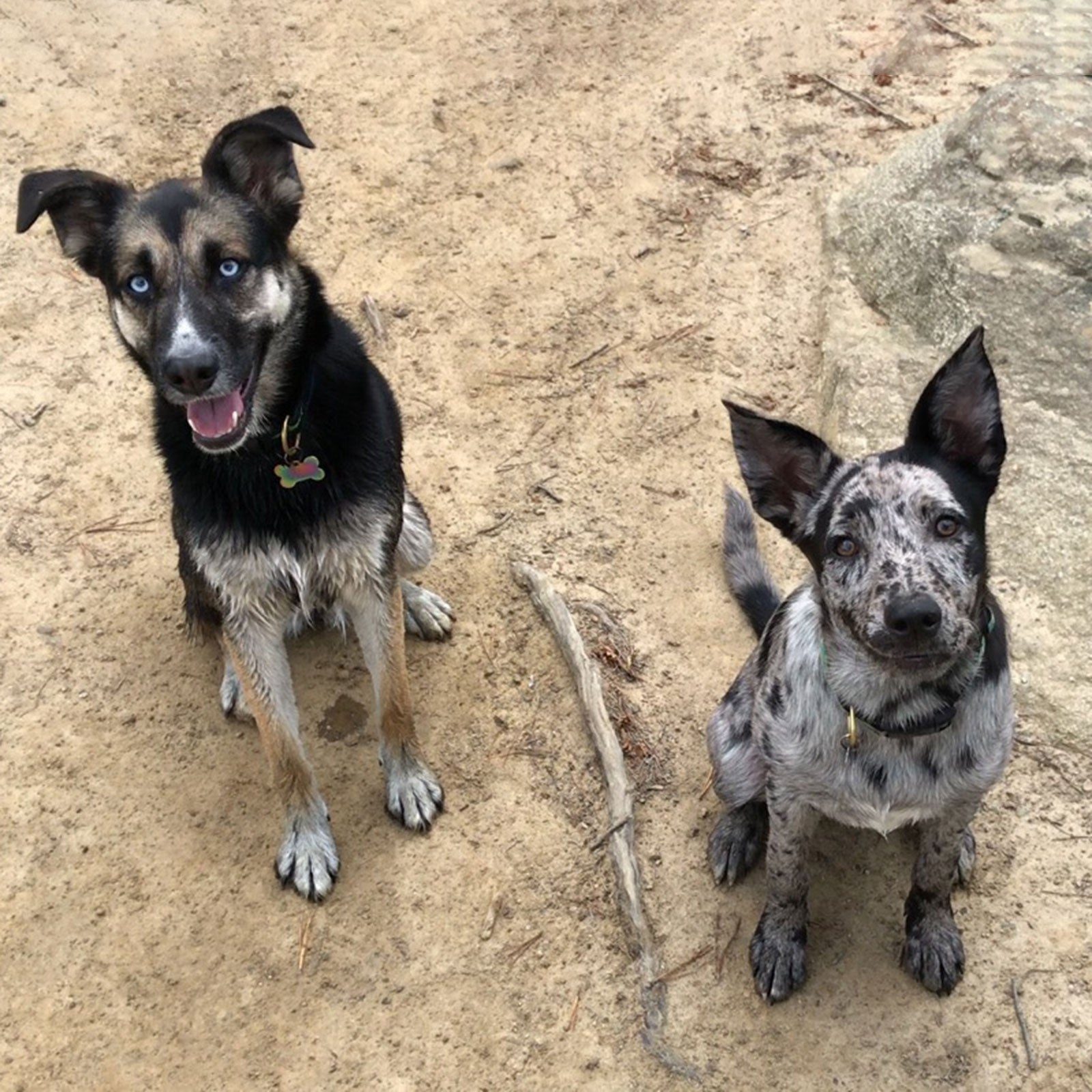Looking back now, I see that the crisis was largely driven by my own hubris.
After failing spectacularly at raising a wild little husky puppy named Ari, I����about my foibles and the inner workings of a dog’s brain. I interviewed canine behaviorists and certified trainers and read every book I could find on operant conditioning. I was convinced I had become an expert.
I managed to maintain the delusion after Ari’s death��three years ago. I continued the misapprehension in the months following, when I adopted Leka, a 14-week-old shepherd mix rescued from a ditch in Mississippi. Leka, unlike Ari, attended a fantastic day school for puppies and became the ideal trail dog—an enthusiastic partner for any backpacking or running project.
She has her quirks—like screaming at the top of her lungs when we visit the vet or try to bathe her—as well as��a��general distrust of dog biscuits and physical affection and toddlers. But these idiosyncrasies aside, Leka is mostly a happy, social dog. So this��spring, my partner, Bill, and I��assumed that Leka would be thrilled to play big sister to an adopted canine sibling.
In preparation for the arrival of our new rescue puppy, Maddox, we��shifted Leka’s feeding schedule and scooped up all her favorite toys, replacing them with neutral ones about which she’d feel less possessive. We��bought Maddox his own beds and dishes, along with baby gates to separate the dogs whenever they needed alone time.
Maddox, a gangly mixed breed, arrived late on a Thursday night. He was as sweet and gentle as his foster mother had promised. Bill��and I watched with relieved gratification when, a couple hours later, Leka engaged him in a gentle game of backyard tag. We congratulated ourselves whenever she sat outside Maddox’s crate or shared a toy.
But as the first week of our blended family came to a close, Leka’s satisfaction with this new arrangement dissipated. She began to sigh whenever Maddox would steal a stuffie or help himself to her treat. She began slinking out of the room whenever he entered. By the end of that second week, Leka’s condition devolved into what can only be called a full-on panic attack. That Friday afternoon, I sat on the couch with a shaking 45-pound shepherd panting in my lap, her heart rate fast enough to detonate any electrocardiograph. Maddox, meanwhile, prowled around below our feet, alternately chewing and peeing on a once lovely area rug.
And I? I sat, surveyed the scene, and began to cry. The house was a disaster. Bill and I were both sleep-deprived. Maddox was a feral hyena who desperately missed his siblings, and Leka was in the midst of a nervous breakdown.
Clearly, I had ruined everyone’s life.
Eventually, Bill returned home from work and sequestered Leka in our bedroom. They spent the evening sharing snacks and enjoying the collective peace afforded by a closed door. Meanwhile, I stopped crying just long enough to clean the rug and take Maddox for a walk. �����ԹϺ���, in the clarifying summer twilight, I was finally willing to admit my own ignorance.
I didn’t know nearly enough about introducing a new dog into an existing one’s life. It was time to summon some more experts.��So I reached out to five leading animal trainers and behaviorists to figure out where we ran off the rails.
We’re finally��back on track, and Maddox has been a part of our family for two months now. Would I do it again? Absolutely. But not before heeding the following advice.

Start with Some Soul-Searching
A lot of people are under the misapprehension that dogs are pack animals, but that’s just not true, says��, a professor of��clinical animal behavior��at the University of California at Davis School of Veterinary Medicine. “Dogs are social animals, like humans,” she says. “That doesn’t mean they always want to be around other dogs.” Her own pet is more than content being the only dog in the house. It’s important to have a sense of whether your dog shares those introverted proclivities. If your dog hasn’t spent a lot of sustained time around other dogs, consider borrowing a friend’s pup for a weekend or arranging��well-monitored��playtime at a dog park or other off-leash area to get a better sense of how it��behaves in social settings.
Play a Little Hard to Get
There are so many dogs in need, it can be tempting to jump into a new relationship based on a photo or sad story. But it’s imperative to know whether or not that dog’s temperament is a good match for your existing canine, warns , a canine trainer and an author of�� on dog interactions and aggression. Ask questions of the rescue organization or shelter;��oftentimes, words like “energetic” and “devoted” can be codes for behavioral issues. If a trial period is possible before adopting, take it. “The worst thing that can happen to a resident dog is for them to live in a house where it’s violent,” she says. “It’s like telling your partner you’ve rented out a room to Hannibal Lecter, but don’t worry, he won’t use our bathroom.”��
Take It Slow—Super Slow
You’d probably advise against a good friend going on a monthlong vacation with someone they just swiped on Tinder. It’s no different in the dog world, says trainer and puppy specialist��. “There’s a reason blind dates usually take place over dinner and a movie,” she says. “Brief, activity-driven interactions build comfort and prevent us from going too far down a bad road.” She recommends taking your resident dog and new dog on what she calls “parallel walks,” where the dogs are close enough to smell and observe each other but not interact physically. Back at home, use crates and baby gates to keep the dogs separated for all but limited, supervised interaction.��
Solve Your Resident Dog’s Bad Behaviors First
A new, younger dog is going to look to your resident dog for guidance, says Sternberg. “If your current dog barks at other dogs on the street, he will teach those behaviors to the new dog,” she explains. Ditto, she says, if your resident dog bolts every time you open the door or tears apart the house whenever you leave. If you’re working on issues with your current dog—especially aggressive behaviors—now isn’t the time to add to the family.��
Be an Advocate
A new interloper in the house is a big and often unpleasant change for even the most social dogs, says��, a clinical behavioral-medicine fellow at the North Carolina State College of Veterinary Medicine. Some resident dogs may become possessive and aggressive; others, like Leka, may grow increasingly meek and anxious. The trick, says Pankratz, is to be ready to respond. “Be open and compassionate as well as ensuring safety.” In the case of Leka, she says, I probably would have been better off returning her toys to her to give her more confidence��that her place in the house was secure. If Maddox kept taking them, I could have separated him to give��Leka time with her stuffies in peace. After talking to Pankratz, we started feeding Maddox in a separate room, and Leka became a lot less frantic about having her dinner stolen.
Avoid Playing Favorites
When my friend Kate adopted a second dog, she was so worried that her resident dog would feel sad that she didn’t spend much time bonding with the new addition. I was so worried baby Maddox missed his siblings that I neglected Leka. Both, says animal behaviorist��, are common mistakes when building blended canine families. The key to success, he says, is to make sure both dogs get individual time with you,��either on solo walks or during play sessions. During training time, use a baby gate to separate two rooms, and use��that barrier to your advantage. “A lot of times, I’ll literally straddle the gate and train both dogs on either side,” he says. “It’s a good way to help them learn not to be jealous with one another.” Or he’ll train one dog on one side while giving the other dog a��favorite toy or chew treat to enjoy. “A dog can learn really quickly that positive interaction is almost dependent on the other dog being around.”
Know the Warning Signs��
That sounds like a no-brainer, says UC Davis’s Bain, but a lot of pet owners don’t know the early signs of anxiety or aggression. One of the most common misconceptions Bain encounters is that dogs are��happy whenever they��wag��their��tail. “I always tell my students: no one’s been bitten by an animal’s rectum,”��she says. “You need to look at the face and see what’s going on there.” Averted eyes, a fixed lip, or panting are all examples of discomfort. They’re subtle, says Bain, so familiarize yourself with charts like����on fear and aggression in dogs.��“Too often, by the time a person has identified that there’s a problem between the dogs, they are five days too late,” she says.
Remember Those Childhood Car Rides
Growing up, my younger brother and I hated being in the back seat together. I’d draw an imaginary line down the middle and demand he respect the boundary. He made a point of doing anything but. When I finally hauled off and shoved him, you can guess who got in trouble. The same thing happens all the time when a new puppy enters the house, says Sternberg. “Again and again, I see people punishing the wrong dog. That’s just going to make the resident dog more anxious and stressed, while it gives the new one permission to take more advantage.” You never want to allow physical aggression to get out of hand, but it’s also OK��for the resident dog to scold or correct the puppy when things start to escalate: a dirty look, a warning bark, or a quick growl are all useful feedback for the younger dog. Just be ready to step in if that warning isn’t heeded.
Make De-escalation Fun
Even the best behaved dog can get overstimulated and lose impulse control or start ignoring cues from other dogs. When a play session starts to get heated or one dog��looks like he’s making bad choices, it’s time to reroute everyone’s energy and focus. Logan recommends “interrupting picnics,” in which you call both dogs into another room, ask them to sit, and reward them��with treats while they stay. “Don’t underestimate the value of teaching even simple skills, like attention and eye contact,” she says. “The more skills they have, the better they are set up for success. And you always want their attention returning to you.” If a picnic isn’t working,��tether��the dogs so that they’re in the same room but can’t physically interact with one another. This also teaches the puppy he can’t necessarily get access to every toy or human he wants.
Don’t Go It Alone
We know to take our dog to the vet when she’s sick, but too few people know to consult with a professional when a dog is in distress, says Ramirez. He recommends working with a certified trainer who specializes in positive-reinforcement training from the start of any new relationship—both with your resident dog��and your new dog. If problems start to arise, contact your veterinarian for advice or additional referrals. “Every dog is different,” says Ramirez. “The best thing you can do is come into the situation knowledgeable and ready to help them find a new normal that feels safe and secure.”


